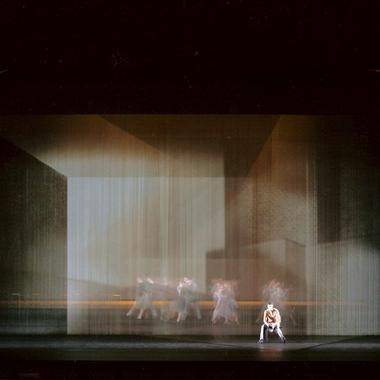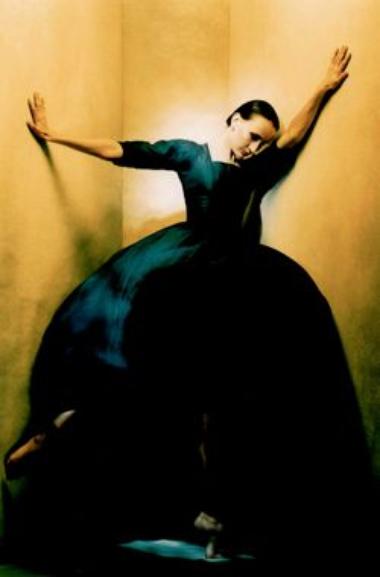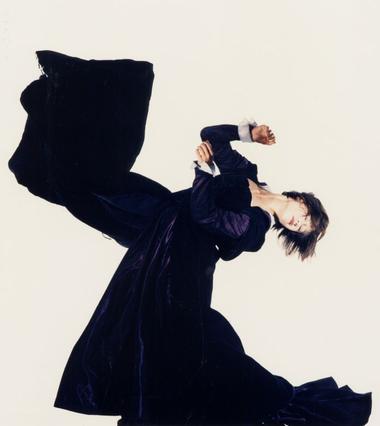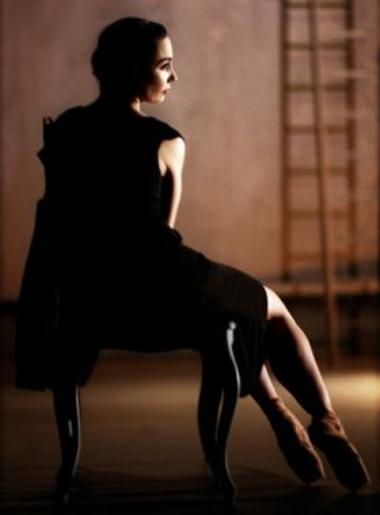Kim Brandstrup
Cinematic space and projection

Cinematic space and projection
"Brandstrup seems to create his works like a filmmaker, an invisible camera panning over the dancers. Action is fast and varied, like a series of beautifully cut shots" - Stephanie Ferguson
Kim Brandstrup studied cinema before turning to dance, and that focus informs much of his work to date. Envying the physical freedoms of film, he has long sought to extend the limitations of the theatrical space, working with designers to create fictional universes and lucidly suggestive spaces, that allow for rapid shifts in time and space.
In 2001 with filmmakers The Brothers Quay and video artist Syvain Robert he created The Queen of Spades: the first full-length ballet performed entirely in a virtual space of video projection.
As the technology develops and especially in his recent collaborations with Leo Warner and 59productions projection has found an integral role in his work .
narrative experiments

narrative experiments
"For Kim Brandstrup the role of the storyteller and the role of the artist have long been inseparable: ‘telling stories’ he believes ‘is what connects us to our shared humanity’. Holding this belief has led him to become one of the leading narrative choreographers of his generation." - Judith Mackrel
To make movement yield a sense of narrative has always been an obsession in Kim Brandstrup's work. He finds inspiration in the most canonical of sources, Shakespeare, Dostoyevsky, Greek mythology; but his narrative experiments are a long way from classic dance narration. He has challenged and transformed these epic narratives into compelling, contemporary, human tales. Often with a raw and intimate quality as if wrestled from his dancers themselves.
"The choice of story is inseparable from the dancer I have in mind casting, Without Irek Mukahmedov, no Othello; without Jeremy James, no Hamlet; without Joanna Fong, no Natasha Fillipova (in Dostoyevsky's The Idiot ). It is the creative surge that you get from imagining a particular dancer in a certain (sometimes unlikely) role, that drives these pieces into existence. It was Irek's regal and proud outsider in a group of contemporary dancers that made him such a stranger and his fall so much greater. I think the ultimate power and justification of a piece like Antic(1993), was us seeing Hamlet as a very young boy suddenly thrown into a tough world of adult power - his devastation, doubts and indecisiveness take on a new meaning if he looked like an abandoned child as Jeremy always did." Kim Brandstrup
KB’s ability, to get under the skin of the characters, (and his dancers), to evoke both subtle and ambiguous feelings, to render the subtext of a story visible, has produced a series of works that he likes to refer to as commentaries or 'takes’ on existing narratives, with his dancers as the crucial creative centre. His two pieces prompted by Dostoyevsky's The Idiot Elegy (2001), and Rushes (2008), serve as clear examples. The first, inspired and evolving around Natasha Phillipova in the powerful incarnation of Joanna Fong, the other around Carlos Acosta's distraught and violent portrayal of Rogozin. Two completely different works in both language , mood and content prompted by the same source .
Projects in Music

Music
Even if Kim Brandstrup’s theatre is permeated with images, the influence from cinema all pervasive, and his works seem propelled by narrative logic, he himself holds that music is the single most important influence on his creative work. He has always maintained that it is the synergy between music and movement that gives the pieces the sense of narrative drive.
"Music inhabits the mysterious no man’s land between mathematical construction and human emotion - nothing is so abstract in its means and yet so immediate in its effect. I think dance floats in the same sphere. Any choreographic choice you make has to seem to obey both logics. It has to be aware of the formal map the music sets up while looking dramatically inevitable from the point of view of the characters involved on stage. The great challenge, the fun and satisfaction you get creatively, is through navigating between the two - so you as a spectator are never really sure or even aware what drives the piece - whether it is the formal or the human, the conceptual or the narrative - whether all is planned or a product of chance." Kim Brandstrup.
Kim Brandstrup’s understanding of music has been integral to his work as a choreographer. At the beginning of his career Kim received commissions by the London Sinfonietta. An exploration of 20th century music followed, resulting in works set to scores from Stravinsky, Schoenberg, Gubaidulina, and Schnittke.
He has himself commissioned twenty scores, and worked in close collaboration with a number of contemporary composers, notably for his big full-length narrative pieces such as Amor & Psyche, Hamlet, and Queen of Spades.
Since 2001 he has revisited the 17th and 18th century with renewed fervour and curiosity, and has tackled some of the iconic scores of the classical cannon. These have included Handel’s Messiah, Brahms’ Variations and Fugue on a Theme by Handel, and Bach’s Goldberg Variations.
Full Works

Full Length Works
“[Goldberg] is an ingeniously organised, frequently humorous, gently enigmatic and wholly luminous hour and a quarter – a mini-masterpiece” - Jenny Gilbert
Kim Brandstrup first took up the challenge of the full evening ballet in 1990 when he created Peer Gynt and has since made eleven full-length dance works. From the beginning the works were imbued by cinematic dramaturgy and in pieces like Peer Gynt (1990), Antic (1993), and Othello (1994), he created tightly paced contemporary tales from complex classic narratives, pairing them right down to their dramatic essence.
His love for and knowledge of the large scale ballet cannon is clearly demonstrated in his three full-length classical works: Amor and Psyche (1997), Sleeping Beauty (1998), and Queen of Spades (2001).
The trilogy demonstrate his grasp of epic narrative scale and are at once affectionate homages to the nineteenth century form and a strong bid for reinventing it.
More recently, in pieces like Goldberg(2009), Hamlet (2003), and Brothers (2002), he has played with a more poetic, multi-layered narrative language that while still tightly structured has a looser and more poetic eloquence in its story telling.
awards and nominations

awards and nominations
MACHINA - 2012
Nominated for a South Bank Skye Arts Award
iNVITUS INVITAM - 2011
Nominated for a Crtics Award for Best Classical Choreography
GOLDBERG - THE BRANDSTRUP-ROJO PROJECT - 2010
Olivier Award for Best New Dance Production
Nomination for the Critics’ Circle award for Best Classical Choreography
TWO FOOTSNOTES TO ASHTON - 2005
Nomination for the Critics’ Circle award for Best Classical Choreography
ELEGY - 2001
Nomination for TMA Best Dance Production
SAINTS AND SHADOWS - 1995
Nomination for the Olivier Award for Best New Dance Production
OTHELLO - 1994
Evening Standard Award for Best New Dance Production
ORPHEO - 1989
Olivier award for Most Outstanding Achievement in Dance